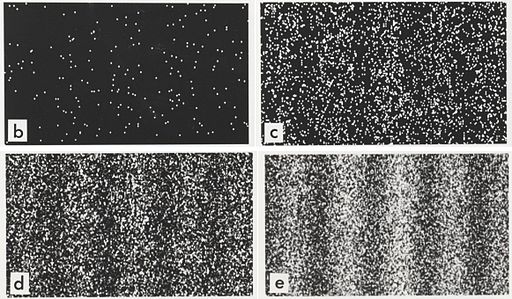Meaning of Wavefunctions
Measured Value
All observable quantities have their operators. $$\hat{A}\phi = a\phi$$ \(\phi\) is called the eigenstates or eigenfunction of \(\hat{A}\) and \(a\) is the eigenvalue of \(\hat{A}\)The observed quantity of an observable quantities must be the eigenvalues of \(\hat{A}\), hence must be real (if the value is imaginary, we cannot observe it in the real world). The eigenfunction should be othonormal.
e.g. The operator of \(p\) is \(\frac{\hbar}{i}\frac{d}{dx}\). $$\frac{\hbar}{i}\frac{d}{dx}e^{ikx} = \frac{\hbar}{i}(ik)e^{ikx} = pe^{ikx}$$ Hence, its eigenfunction is \(e^{ikx}\) while \(p\), the eigenvalue, is the measured value.
e.g. The operator of \(x\) is \(x\). $$x\delta(x - x_0) = x_0\delta(x - x_0)$$ Hence, its eigenfunction is \(\delta(x - x_0)\) while \(x_0\), the eigenvalue, is the measured value.
Probability of Measurement
The state of a particle at a scale where quantum effect is significant is given by the wavefunction \(\psi\). Information of any observable quantities can be found in the wavefunction.
■ Results of a double-slit experiment done by Dr. Tanamura that illustrate the build-up of interference pattern of single electrons
Or if \(A\) is continuous $$\psi(x) = \int c(A)\phi(x;A)dA$$ where \(|c(A)|^2\) is the probability density. e.g. \(\psi(x) = \int \psi(x)\delta(x)dx\) The probability density is $$|\psi(x)|^2$$ The probability of finding \(x\) between \(x_1\) and \(x_2\) is $$\int_{x_1}^{x_2} |\psi(x)|^2 dx$$
Collapse of State
After measuring \(A\) to be \(A_i\) in \(\hat{A}\phi_i(x;A) = A_i\phi_i(x;A)\), the state is collapsed to $$\psi = \phi_i(x;A)$$ If \(\hat{B}\) commutes with \(\hat{A}\), i.e. $$[\hat{A},\hat{B}] = \hat{A}\hat{B} - \hat{B}\hat{A} = 0$$ then the value of \(B\) is also determined.If not, $$\psi = \sum_i c_i\xi_i(x;B)$$ for some non-zero \(c_i\)
and \(B\) is not uniquely determined. If \(B\) is then measured to be \(B_i\) in \(\hat{B}\xi_i(x;B) = B_i\xi_i(x;B)\), the state is collapsed to \(\psi = \xi_i(x;B)\). Then, the state is altered from \(\psi = \phi_i(x;A)\) to $$\psi = \xi_i(x;B) = \sum_i c_i\phi_i(x;A)$$ for some non-zero \(c_i\)
\(A\) will become not uniquely determined.
Expectation Value
Expectation value is calculated by \(\sum_i P_iA_i\) where \(P_i\) is the probability of getting \(A_i\). \begin{align} \psi(x) &= \sum_{i}c_i\phi_i(x;A) \\ \hat{A}\psi(x) &= \sum_{i}c_i\hat{A}\phi_i(x;A) \\ &= \sum_{i}c_iA_i\phi_i(x;A) \\ \psi(x)^*\hat{A}\psi(x) &= \psi(x)^*\sum_{i}c_iA_i\phi_i(x;A) \\ &= (\sum_{i}c_iA_i\phi_i(x;A)^*)(\sum_{i}c_iA_i\phi_i(x;A)) \\ &= \sum_{i}|c_i|^2A_i \\ \end{align} as \(\phi_i\) are othonormal.If \(A\) is continuous, then the expectation value is defined as $$\int \psi^* \hat{A} \psi dA$$


Comments
Post a Comment